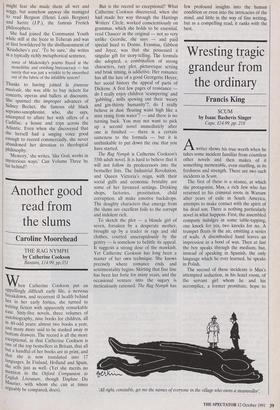Another good read from the slums
Caroline Moorehead
THE RAG NYMPH by Catherine Cookson Bantam, £14.99, pp.351 hen Catherine Cookson put an appallingly difficult early life, a nervous breakdown, and recurrent ill health behind her in her early forties, she turned to writing fiction with apparently remarkable ease. Sixty-five novels, three volumes of autobiography, nine books for children, all m 40-odd years: almost two books a year, and many more said to be stashed away in bottom drawers. The record is all the more exceptional, in that Catherine Cookson is one of the top bestsellers in Britain, that all but a handful of her books are in print, and that she is now translated into 17 languages. In Finland, Holland and Spain, She sells just as well. (Yet she merits no mention in the Oxford Companion to English Literature, though Daphne Du Maurier, with whom she can at times arguably be compared, does).
But is the record so exceptional'? What Catherine Cookson discovered, when she had made her way through the Hastings Writers' Circle, worked conscientiously on grammar, which she holds to be essential, read Chaucer in the original — not, so very unlike Geordie, she says — and paid special heed to Donne, Erasmus, Gibbon and Joyce, was that she possessed a singular gift for story-telling. The formula she adopted, a combination of strong characters, racy plot, picturesque setting and brisk timing, is addictive. Her romance has all the lure of a good Georgette Heyer; her social history the appeal of parts of Dickens. A first few pages of resistance do I really enjoy children 'scampering' and `gabbling', mills spewing out their 'weary and gin-thirsty humanity'?; do I really believe in dust 'floating waist high like a mist rising from water'? — and there is no turning back. You may not want to pick up a second novel immediately after one is finished — there is a certain sameness to the formula — but it is unthinkable to put down the one that you have started.
The Rag Nymph is Catherine Cookson's 55th adult novel. It is hard to believe that it will not follow its predecessors into the bestseller lists. The Industrial Revolution, and Queen Victoria's reign, with their social gulfs and economic brutality are some of her favoured settings. Drinking shops, factories, prostitution, child corruption, all make emotive backdrops. The doughty characters that emerge from the slums are excellent foils to the corrupt and indolent rich.
To sketch the plot — a blonde girl of seven, forsaken by a desperate mother, brought up by a trader in rags and old clothes, courted unscrupulously by the gentry — is somehow to belittle its appeal. It suggests a strong dose of the mawkish. Yet Catherine Cookson has long been a master of her own technique. She knows precisely where romance ends and sentimentality begins. Skirting that fine line has been her forte for many years, and the occasional venture into the sugary is meticulously rationed. The Rag Nymph has
few profound insights into the human condition or even into the intricacies of the mind, and little in the way of fine writing, but as a compelling read, it ranks with the best.


























































 Previous page
Previous page